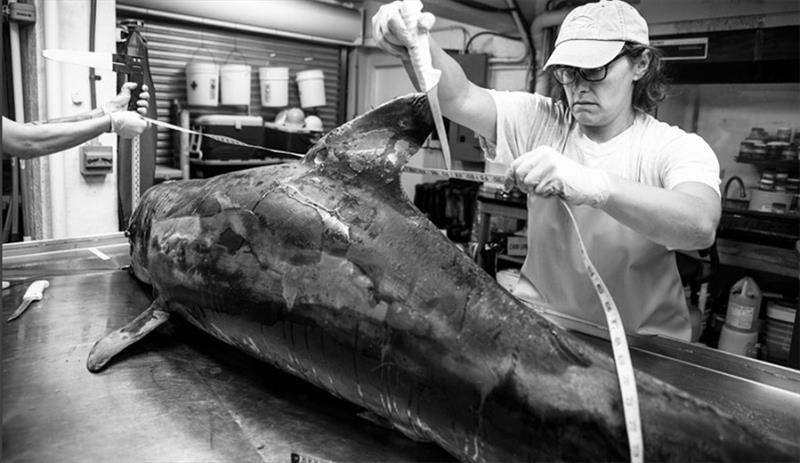
2018 Bottlenose Dolphin Unusual Mortality Event
by NOAA Fisheries 9 Sep 2018 13:39 UTC

Taking measurements of a dead bottlenose dolphin during a necropsy © Mote Marine Laboratory
Since July 2018, elevated bottlenose dolphin mortalities have occurred along the Southwest coast of Florida including Collier, Lee, Charlotte, Sarasota, Manatee, Hillsborough and Pinellas counties. This event has been declared an Unusual Mortality Event (UME).
Southwest Florida has been experiencing an ongoing severe bloom of a red tide organism since November 2017. The dinoflagellate (Karenia brevis) that forms red tide is commonly found at low levels in Gulf waters, but it can have devastating impacts when the cells multiply and form a harmful algal bloom. Other species, such as fish, sea turtles, and manatees are also confirmed to be dying as a result of this ongoing harmful algal bloom.
Why are dolphins stranding?
Our stranding network partners have conducted full or partial necropsy examinations on several dolphins, with positive results for the red tide toxin (brevetoxin) indicating this UME is related to the bloom.
As part of the UME investigation process, an independent team of scientists (Investigative Team) is being assembled to coordinate with the Working Group on Marine Mammal Unusual Mortality Events to review the data collected and provide guidance for the investigation.
The Investigative Team will continue to conduct sampling and testing and we will update results as we learn more.
There was a 2005-2006 multi-species UME caused by exposure to red tide toxins that ranged along the Southwest Florida coast and involved ~190 dolphins, so an event like this has occurred before.
Report a stranded or floating dolphin
The most important step members of the public can take to assist investigators is to immediately report any sightings of live dolphins in distress or stranded, or dead dolphins. Make the report by calling the Southeast Marine Mammal Stranding Hotline at 877-WHALE HELP (877-942-5343) or contact the U.S. Coast Guard on VHF Channel 16. Please, do not approach or touch the dolphin. The stranding network will send out trained responders who will get to the scene quickly with appropriate equipment.
All marine mammals are federally protected by the Marine Mammal Protection Act (MMPA). Only local and state officials and people authorized by NOAA Fisheries may legally handle live and dead marine mammals.
Helping dolphins - Do's and don'ts
- DON'T push the animal back out to sea! Stranded marine mammals may be sick or injured. Returning animals to sea delays examination and treatment and often results in the animal re-stranding in worse condition.
- If the animal returns to the water on its own, DON'T attempt interact with it (swim with, ride, etc.).
- DO put human safety above animal safety. If conditions are dangerous, do not attempt to approach the animal.
- DO stay with the animal until rescuers arrive, but use caution. Marine mammals can be dangerous and/or carry disease. Keep a safe distance from the head and tail. Do not touch the animal and avoid inhaling the animal's expired air.
- If the animal is alive, DO keep its skin moist and cool by splashing water over its body. Use wet towels to help keep the skin moist and prevent sunburn.
- If the animal is alive, DON'T cover or obstruct the blowhole. Try to keep sand and water away from the blowhole.
- DO keep crowds away and noise levels down to avoid causing further stress to the animal.
- DO report all dead marine mammals, even if they are decomposed to 877-WHALE HELP (877-942-5343).
- DO keep dogs/pets away from the live or dead marine mammal.
- DON'T collect any parts (tissues, teeth, bones, or gear, etc.) from dead animals. They are still covered by the Marine Mammal Protection Act.
Additional Information